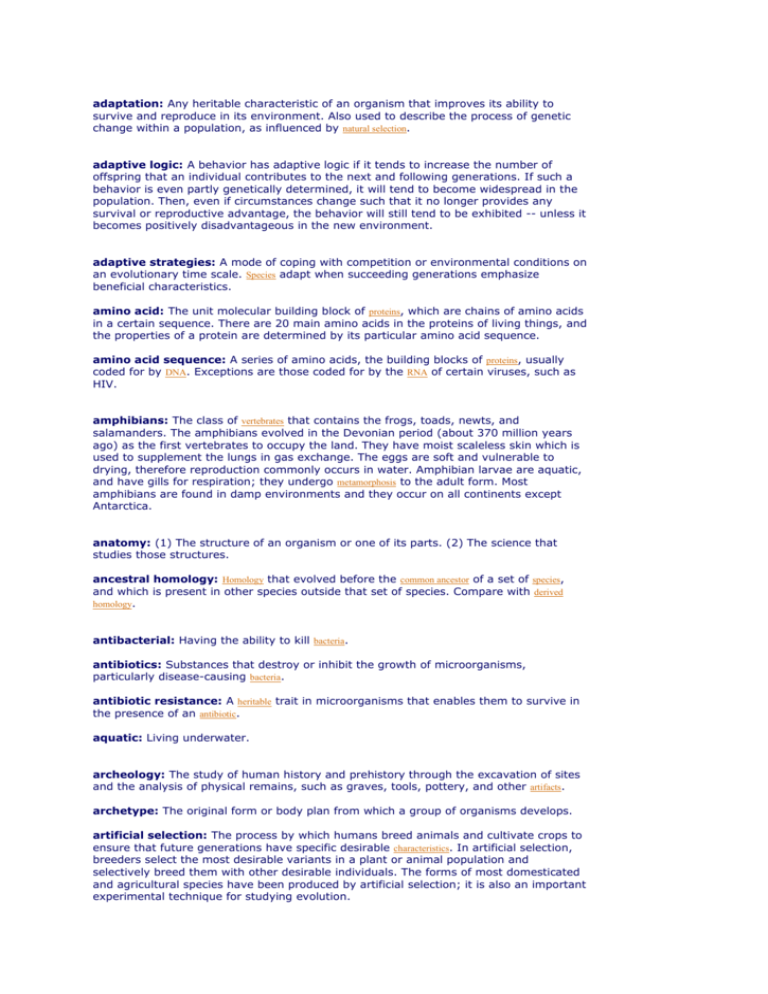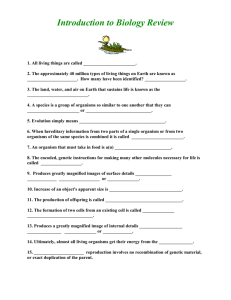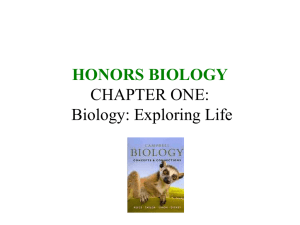evolution-glossary
advertisement

adaptation: Any heritable characteristic of an organism that improves its ability to survive and reproduce in its environment. Also used to describe the process of genetic change within a population, as influenced by natural selection. adaptive logic: A behavior has adaptive logic if it tends to increase the number of offspring that an individual contributes to the next and following generations. If such a behavior is even partly genetically determined, it will tend to become widespread in the population. Then, even if circumstances change such that it no longer provides any survival or reproductive advantage, the behavior will still tend to be exhibited -- unless it becomes positively disadvantageous in the new environment. adaptive strategies: A mode of coping with competition or environmental conditions on an evolutionary time scale. Species adapt when succeeding generations emphasize beneficial characteristics. amino acid: The unit molecular building block of proteins, which are chains of amino acids in a certain sequence. There are 20 main amino acids in the proteins of living things, and the properties of a protein are determined by its particular amino acid sequence. amino acid sequence: A series of amino acids, the building blocks of proteins, usually coded for by DNA. Exceptions are those coded for by the RNA of certain viruses, such as HIV. amphibians: The class of vertebrates that contains the frogs, toads, newts, and salamanders. The amphibians evolved in the Devonian period (about 370 million years ago) as the first vertebrates to occupy the land. They have moist scaleless skin which is used to supplement the lungs in gas exchange. The eggs are soft and vulnerable to drying, therefore reproduction commonly occurs in water. Amphibian larvae are aquatic, and have gills for respiration; they undergo metamorphosis to the adult form. Most amphibians are found in damp environments and they occur on all continents except Antarctica. anatomy: (1) The structure of an organism or one of its parts. (2) The science that studies those structures. ancestral homology: Homology that evolved before the common ancestor of a set of species, and which is present in other species outside that set of species. Compare with derived homology. antibacterial: Having the ability to kill bacteria. antibiotics: Substances that destroy or inhibit the growth of microorganisms, particularly disease-causing bacteria. antibiotic resistance: A heritable trait in microorganisms that enables them to survive in the presence of an antibiotic. aquatic: Living underwater. archeology: The study of human history and prehistory through the excavation of sites and the analysis of physical remains, such as graves, tools, pottery, and other artifacts. archetype: The original form or body plan from which a group of organisms develops. artificial selection: The process by which humans breed animals and cultivate crops to ensure that future generations have specific desirable characteristics. In artificial selection, breeders select the most desirable variants in a plant or animal population and selectively breed them with other desirable individuals. The forms of most domesticated and agricultural species have been produced by artificial selection; it is also an important experimental technique for studying evolution. asexual reproduction: A type of reproduction involving only one parent that ususally produces genetically identical offspring. Asexual reproduction occurs without fertilization or genetic recombination, and may occur by budding, by division of a single cell, or by the breakup of a whole organism into two or more new individuals. assortative mating: The tendency of like to mate with like. Mating can be assortative for a certain genotype (e.g., individuals with genotype AA tend to mate with other individuals of genotype AA) or phenotype (e.g., tall individuals mate with other tall individuals). asteroid: A small rocky or metallic body orbitting the Sun. About 20,000 have been observed, ranging in size from several hundred kilometers across down to dust particles. autosome: Any chromosome other than a sex chromosome. avian: Of, relating to, or characteristic of birds (members of the class Aves). bacteria: Tiny, single-celled, prokaryotic organisms that can survive in a wide variety of environments. Some cause serious infectious diseases in humans, other animals, and plants. base: The DNA molecule is a chain of nucleotide units; each unit consists of a backbone made of a sugar and a phosphate group, with a nitrogenous base attached. The base in a unit is one of adenine (A), guanine (G), cytosine (C), or thymine (T). In RNA, uracil (U) is used instead of thymine. A and G belong to the chemical class called purines; C, T, and U are pyrimidines. big bang theory: The theory that states that the universe began in a state of compression to infinite density, and that in one instant all matter and energy began expanding and have continued expanding ever since. biodiversity (or biological diversity): A measure of the variety of life, biodiversity is often described on three levels. Ecosystem diversity describes the variety of habitats present; species diversity is a measure of the number of species and the number of individuals of each species present; genetic diversity refers to the total amount of genetic variability present. bioengineered food: Food that has been produced through genetic modification using techniques of genetic engineering. biogenetic law: Name given by Haeckel to recapitulation. biogeography: The study of patterns of geographical distribution of plants and animals across Earth, and the changes in those distributions over time. biological species concept: The concept of species, according to which a species is a set of organisms that can interbreed among each other. Compare with cladistic species concept, ecological species concept, phenetic species concept, and recognition species concept. botanist: A scientist who studies plants. Darwinian evolution: Evolution by the process of natural selection acting on random variation. Darwinism: Darwin's theory that species originated by evolution from other species and that evolution is mainly driven by natural selection. Differs from neo-Darwinism mainly in that Darwin did not know about Mendelian inheritance. Darwin, Charles: The 19th-century naturalist considered the father of evolution. His landmark work, On the Origin of Species, published in 1859, presented a wealth of facts supporting the idea of evolution and proposed a viable theory for how evolution occurs -- via the mechanism Darwin called "natural selection." In addition to his prolific work in biology, Darwin also published important works on coral reefs and on the geology of the Andes, and a popular travelogue of his five-year voyage aboard HMS Beagle. DNA: Deoxyribonucleic acid, the molecule that controls inheritance. DNA base sequence: A chain of repeating units of deoxyribonucleotides (adenine, guanine, cytosice, thymine) arranged in a particular pattern. ecological genetics: The study of evolution in action in nature, by a combination of field work and laboratory genetics. ecosystem: A community of organisms interacting with a particular environment. embryo: An early stage of animal development that begins after division of the zygote (the earliest stage, in which joined egg and sperm have not yet divided). embryonic: Related to an embryo, or being in the state of an embryo. embryology: scientific study of the earliest stages of growth and development in organisms. emigration: The movement of organisms out of an area. enzyme: A protein that acts as a catalyst for chemical reactions. evolution: Darwin defined this term as "descent with modification." It is the change in a lineage of populations between generations. In general terms, biological evolution is the process of change by which new species develop from preexisting species over time; in genetic terms, evolution can be defined as any change in the frequency of alleles in populations of organisms from generation to generation. evolutionary classification: Method of classification using both cladistic and phenetic classificatory principles. To be exact, it permits paraphyletic groups (which are allowed in phenetic but not in cladistic classification) and monophyletic groups (which are allowed in both cladistic and phenetic classification) but excludes polyphyletic groups (which are banned from cladistic classification but permitted in phenetic classification). extinction: The disappearance of a species or a population. fact: A natural phenomenon repeatedly confirmed by observation. family: The category of taxonomic classification between order and genus (see taxon). Organisms within a family share a close similarity; for example, the cat family, Felidae, which includes lions and domestic cats. fetus: The embryo of a mammal that has reached a stage of development in the uterus in which most of the adult features are recognizable. Specifically in humans it refers to the stage of development after the appearance of bone cells, a process occurring 7 to 8 weeks after fertilization. fossil: Most commonly, an organism, a physical part of an organism, or an imprint of an organism that has been preserved from ancient times in rock, amber, or by some other means. New techniques have also revealed the existence of cellular and molecular fossils. fungi: A group of organisms comprising the kingdom Fungi, which includes molds and mushrooms. They can exist either as single cells or make up a multicellular body called a mycelium. Fungi lack chlorophyll and secrete digestive enzymes that decompose other biological tissues. gene: A sequence of nucleotides coding for a protein (or, in some cases, part of a protein); a unit of heredity. genetic: Related to genes. A gene is a sequence of nucleotides coding for a protein (or, in some cases, part of a protein); a unit of heredity. genetics: The study of genes and their relationship to characteristics of organisms. genetic code: The code relating nucleotide triplets in the mRNA (or DNA) to amino acids in the proteins. genetic distance: See distance. greenhouse gases: Gases that absorb and reradiate infrared radiation. When present in the atmosphere, these gases contribute to the greenhouse effect, trapping heat near the surface of the planet. On Earth, the main greenhouse gases are carbon dioxide, water vapor, methane, nitrous oxide, ozone, and some halocarbon compounds. heredity: The process by which characteristics are passed from one generation to the next. HIV: Human Immunodeficiency Virus. The virus causes AIDS by inactivating the T cells of the immune system. hybrid: The offspring of a cross between two species. hypothesis: An explanation of one or more phenomena in nature that can be tested by observations, experiments, or both. In order to be considered scientific, a hypothesis must be falsifiable, which means that it can be proven to be incorrect. IQ: An abbreviation of "intelligence quotient," usually defined as the mental age of an individual (as measured by standardized tests) divided by his or her real age and multiplied by 100. This formulation establishes the average IQ as 100. The usefulness and reliability of IQ as a measure of intelligence has been questioned, in part because of the difficulty of devising standardized tests that are free of cultural biases. kingdom: The second highest level of taxonomic classification of organisms (below domains). Classification schemes at the kingdom level have changed over time. Recent molecular data have generally reinforced the evolutionary significance of the kingdoms Animalia, Plantae, and Fungi. The single-celled eukaryotes once lumped into the kingdom Protista are now known to be very diverse, and not closely related to one another. The prokaryotic organisms once lumped into the kingdom Monera are now considered to belong to separate domains: Eubacteria and Archaea. See taxon. lethal recessive: The case in which inheriting two recessive alleles of a gene causes the death of the organism. lineage: An ancestor-descendant sequence of (1) populations, (2) cells, or (3) genes. linked: Of genes, present on the same chromosome. mammals: The group (specifically, a class) of animals, descended from a common ancestor, that share the derived characters of hair or fur, mammary glands, and several distinctive features of skeletal anatomy, including a particular type of middle ear. Humans, cows, and dolphins are all mammals. meiosis: A special kind of cell division that occurs during the reproduction of diploid organisms to produce the gametes. The double set of genes and chromosomes of the normal diploid cells is reduced during meiosis to a single haploid set in the gametes. Crossing-over and therefore recombination occur during a phase of meiosis. messenger RNA (mRNA): A kind of RNA produced by transcription from the DNA and which acts as the message that is decoded to form proteins. metabolism: The chemical processes that occur in a living organism in order to maintain life. There are two kinds of metabolism: constructive metabolism, or anabolism, the synthesis of the proteins, carbohydrates, and fats which form tissue and store energy; and destructive metabolism, or catabolism, the breakdown of complex substances, producing energy and waste matter. metamorphosis: One or more changes in form during the life cycle of an organism, such as an amphibian or insect, in which the juvenile stages differ from the adult. An example is the transition from a tadpole to an adult frog. The term "complete metamorphosis" is applied to insects such as butterflies in which the caterpillar stage is distinct from the adult. "Incomplete metamorphosis" describes the life histories of insects such as locusts in which the young go through a series of larval stages, each of which bears similarities to the adult. Metamorphosis in both insects and amphibians is controlled by hormones, and often involves considerable destruction of larval tissues by enzymes. mimicry: A case in which one species looks more or less similar to another species. See Batesian mimicry and Müllerian mimicry. mitosis: Cell division. All cell division in multicellular organisms occurs by mitosis except for the special division called meiosis that generates the gametes. molecular clock: The theory that molecules evolve at an approximately constant rate. The difference between the form of a molecule in two species is then proportional to the time since the species diverged from a common ancestor, and molecules become of great value in the inference of phylogeny. monogamy: A reproductive strategy in which one male and one female mate and reproduce exclusively with each other. Contrast with polygyny and polyandry. mutation: A change in genetic material that results from an error in replication of DNA. Mutations can be beneficial, harmful, or neutral. natural selection: The differential survival and reproduction of classes of organisms that differ from one another in one or more usually heritable characteristics. Through this process, the forms of organisms in a population that are best adapted to their local environment increase in frequency relative to less welladapted forms over a number of generations. This difference in survival and reproduction is not due to chance. nervous system: An organ system, composed of a network of cells called neurons, that allows an animal to monitor its internal and external environment, and to move voluntarily or in response to stimulation. neural: Related to nerves and neurons. nomadic: Having to do with nomads, people who live in no fixed place but move in search of food or grazing land for their animals; of a wandering lifestyle. nucleus: A region of eukaryotic cells, enclosed within a membrane, containing the DNA. paleontology: The scientific study of fossils. paradox: A seemingly absurd or contradictory, though often true, statement. parasite: An organism that lives on or in a plant or animal of a different species, taking nutrients without providing any benefit to the host. pathological: Related to or caused by disease. penicillin: The first antibiotic discovered, penicillin is derived from the mold Penicillium notatum. It is active against a wide variety of bacteria, acting by disrupting synthesis of the bacterial cell wall. photosynthesis: The fundamental biological process by which green plants make organic compounds such as carbohydrates from atmospheric carbon dioxide and water using light energy from the Sun. The process has two main phases: the light-dependent light reaction responsible for the initial capture of energy, and the light-independent dark reaction in which this energy is stored in the chemical bonds of organic molecules. Because virtually all other forms of life are directly or indirectly dependent on green plants for food, photosynthesis is the basis for almost all life on Earth. population: A group of organisms, usually a group of sexual organisms that interbreed and share a gene pool. population genetics: The study of processes influencing gene frequencies. primate: A mammal belonging to the order Primates (about 195 species), which includes prosimians, monkeys, apes, and humans. Primates probably evolved from insectivorous climbing creatures like tree shrews and have many adaptations for climbing, including five fingers and five toes with opposable first digits (except in the hind feet of humans). They have well-developed hearing and sight, with forwardfacing eyes allowing binocular vision, and large brains. The young are usually produced singly and undergo a long period of growth and development to the adult form. Most primates are arboreal, but the great apes and humans are largely terrestrial. radioactivity: The emission of energy due to changes in the nucleus of an atom. Such spontaneously released radiation is a characteristic of certain elements and at some levels can be harmful. selection: Synonym of natural selection. species: An important classificatory category, which can be variously defined by the biological species concept, cladistic species concept, ecological species concept, phenetic species concept, and recognition species concept. The biological species concept, according to which a species is a set of interbreeding organisms, is the most widely used definition, at least by biologists who study vertebrates. A particular species is referred to by a Linnaean binomial, such as Homo sapiens for human beings. theory: A well-substantiated explanation of some aspect of the natural world that typically incorporates many confirmed obserations, laws, and successfully verified hypotheses. translation: The process by which a protein is manufactured at a ribosome, using messenger RNA code and transfer RNA to supply the amino acids. zygote: The cell formed by the fertilization of male and female gametes.








